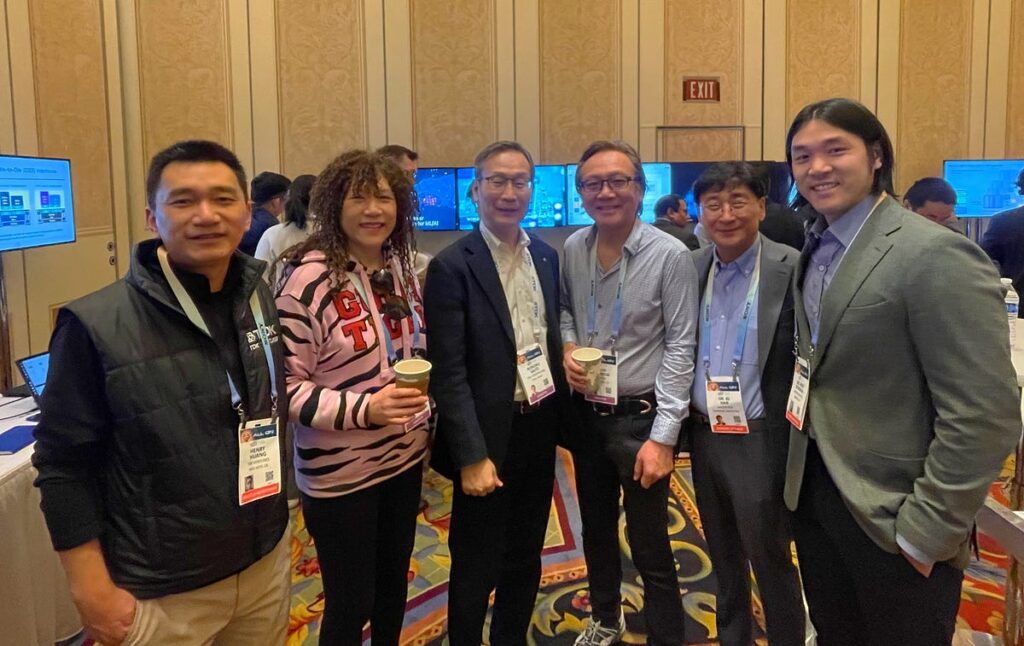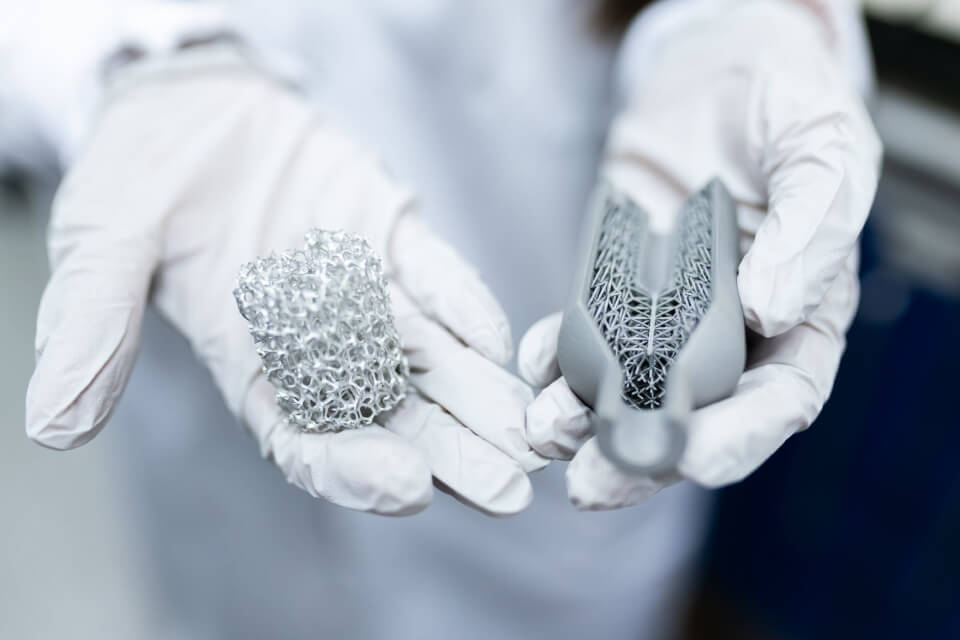Henry Huang, Ph.D. — Investment Director, TDK Ventures
The year was 2015 and, as happens annually, the world’s foremost experts in integrated circuits were coming together for the always highly anticipated technical discussion and exchange of ideas at the International Solid-State Circuits Conference (ISSCC). In this renowned forum, surrounded by some of the brightest minds in the world, Dr. Sehat Sutardja, founder and then CEO of Marvell Technology, introduced his vision of chiplet architecture to the industry [Figure 1]. In his presentation, “The Future of IC Design Innovation”, he drew attention to the — at the time — overlooked limitations in circuitry and semiconductor technology that was the monolithic architecture of a chip. Dr. Sutardja provided a critical perspective (in much more eloquent words) that while chips could continue getting smaller and faster, the constraints of design and performance would remain as long as a monolithic-architecture paradigm remained. Demonstrating incredible vision and creativity, he suggested the innovation of small modular “chiplets”, which could be packaged and combined to form a complete system-on-chip (SoC) [1].
Fast forward eight short years from that meeting to 2023. The age of “Big Data” is truly upon us, with more information than ever before generated every day — millions of terabytes — along with the associated massive demand for power and the ever-increasing cost of it all (both energy and electronic material components). In the very same forum, ISSCC2023, Dr. Lisa Su, CEO of AMD, laid out the problem candidly [2]:
“Over the next decade, we must think of energy efficiency as the most important challenge…”, to which she followed up,
“Probably the largest lever we’ve had recently has been the use of advanced packaging and chiplets…. It allows us to bring the components of compute together much more closely than ever before.”
Dr. Su’s words, and really the context that brought them to bear, provide significant gravitas to the foresight Dr. Sutardja was able to provide years before. As the age of Moore’ Law comes to a close, we don’t just need smaller or faster chips, but instead a new paradigm altogether from monolithic chip architecture. We need SoC capabilities through chiplet architecture and chiplet packaging.
What is chiplet technology?
As a baseline, the traditional monolithic chip architecture consists of off functions/cores of a circuit integrated onto a single silicon die. A chiplet, in contrast, disaggregates all functions into modular interoperable units. Each of these may be optimized for a specific function and “mixed and matched” together to create a comprehensive system [Figure 2]. In the other word, the chiplet-design architecture is like playing Legos!
In the context of the modular and interchangeable chiplet architecture, there is the additional — and distinct — characteristic of how each chiplet is placed and arranged (i.e. packaged) with respect to each other. Also called “advanced packaging”, as these techniques may be applied more generally, this could mean arranging chiplets flat and around each other and/or stacking them vertically [Figure 3].
Chiplet concept represents a groundbreaking shift in semiconductor IC design, offering advantages that cater to the evolving demands of the technology industry. At the core of it all, the scaling and refinement of monolithic chip architectures are altogether more costly as a function of performance and complexity (in a nonlinear fashion), while additional complexity/performance is improved and enhanced through the chiplet paradigm [Figure 4].
Value-added aspects include [6, 7]:
§ Increased Design Flexibility: Chiplets offer unparalleled flexibility in design. Manufacturers can mix and match different chiplets to create custom SoCs tailored to specific market needs or technological requirements. This flexibility allows for rapid adaptation to new trends or changes in technology, keeping pace with the fast-evolving tech landscape.
§ Cost-Effectiveness: Developing smaller, modular chiplets is generally less costly than fabricating large, monolithic chips. The use of chiplets can lead to improved yields, as smaller chips are less likely to have defects. Additionally, the ability to reuse chiplets across different SoCs reduces R&D costs and accelerates time-to-market.
§ Enhanced Performance: Chiplets are tailored to optimize specific tasks by integrating specialized processing elements. This design allows for a more efficient allocation of resources, where each chiplet can be fine-tuned for a particular function, such as processing, memory, or graphics. The collective performance of these specialized chiplets often surpasses that of a comparable monolithic chip, especially in complex tasks like AI processing and data analytics.
§ Scalability and Customization: Chiplets enable a scalable approach to building SoCs. Companies can develop a range of products, from low-end to high-end, using the same set of chiplets, adjusting the combination and configuration as needed. This scalability extends to customization, allowing for tailored solutions that can meet diverse customer requirements without the need for entirely new designs.
§ Reduced Power Consumption: The smaller size of individual chiplets contributes to lower power consumption. Each chiplet can be optimized for energy efficiency, and the overall system can be designed to minimize power waste. This feature is particularly crucial as the demand for energy-efficient technology grows in sectors like mobile computing and data centers.
§ Futureproofing and Innovation: As technology continues to advance, chiplets provide a platform for innovation. They allow for the integration of newer, more advanced chiplets into existing architectures, ensuring that systems can be upgraded without a complete redesign. This aspect is vital for future-proofing technology in a rapidly changing industry.
Silicon Box: King of the Hill Innovator
It’s here where we return to the story of Dr. Sutardja — or really the greater story of chiplet technology and Silicon Box’s journey to changing the IC game. Not only did he have the foresight of vision to anticipate the inevitable chiplet trend, but he was among the best in the world to put those words to action. In 2021, Dr. Sutardja, Ms. Weili Dai (co-founder of Marvell Technology) and Dr. Byung Joon Han (previous Chairman and CEO of STATS ChipPAC) together founded Silicon Box — with the core mission to bring the revolutionary power of chiplets and chiplet packaging to the semiconductor market. As a team, their combined expertise has resulted in more than 800 patents, more than 50 scholarly publications, and the best-in-world mastery of bringing semiconductor technologies to the industry.
Silicon Box has wasted no time in becoming the “King of the Hill” innovator through their chiplet development and packaging solutions. Their ingenious technology distinguishes itself in two key aspects: (1) an industry-best interconnection, and (2) novel panel packaging instead of the standard wafer approach. The result is up to 8x more production compared to the current state of the art, showcasing the revolutionary potential of chiplet packaging and the superior performance it can bring to bear. Their manufacturing process sets a new industry standard for large scale, high yield production, tailored for advanced chiplet interconnection. It is more reliable and cost effective due to the standardized packaging process for the shortest chiplet-to-chiplet interconnection with better thermal and electrical performance.
Why We Invested in Silicon Box
Our introduction to Silicon Box and subsequent investment was really the culmination of several deep explorations into a few technical areas, as well as three other previous ventures that highlighted the need for complementary technical solutions.
Since 2022, we have conducted a series of deep explorations into: Silicon Photonics, AI Accelerator, and Field Programmable Gate Array (FPGA). With these as context, we developed an in-depth understanding of the importance of fast, efficient, and low-cost hardware technologies in order to process the millions of terabytes of data being generated every day, data which was inherently critical to the continued development of AI and other Big Data reliant solutions. We also grew to understand the role of system connections in processing and how, in many cases, network inter/intra-connects represented the bottleneck of performance. This led us to critical investments in Groq (compute to accelerate workloads in AI/ML/high-performance computing), Analog Inference (edge AI inference accelerators using novel analog in-memory compute), and Nubis Communications (high-bandwidth and low-power optical interconnects). It also led us to what we saw as a pervasive enabling technology that could unlock progress across industries: the chiplet and chiplet packaging.
Aligning with our core mission and vision, progress via chiplet technology represented key advances in both digital transformation (data processing and connectivity), as well as energy transformation (via low cost and efficiency). Chiplets also represent a crucial megatrend for silicon providers across the board with a huge market. For example, in 2022, the AI chip market was at $44B and forecasted to increase to $120B by 2027 [8].
Leveraging our deep explorations, we developed an investment thesis contingent on four crucial “King of the Hill” indicators for chiplet/chiplet packaging solutions:
§ Innovation in chiplet-to-chiplet interconnect that improves the performance and reduces the cost.
§ Demonstrated production capability with large wafer size and high yield.
§ Extensive technical and operational expertise within the team.
§ Strong investor partnership and ecosystem building that could back the significant infrastructure cost required upfront.
With an investment thesis set, what we later realized was it was a matter of time, not if, before we partnered with Silicon Box. Their technological innovations represent the very best in the industry. The panel design, coupled with shortest chiplet-to-chiplet interconnect, makes complexity a very good thing in the problem of computing, truly transcending the traditional definition of a chip solution and providing the chiplet solution with unmatched power and performance. We see their technology as an enabler of the next generation and opening the future to boundless possibilities as their approach makes it easier for foundries, chip designers, and OSATs to collaborate to build chips for the most cutting-edge applications. What’s more, they have what could only be described as the best team in the world to tackle their vision for progress, a vision which TDK Ventures is equally passionate for. Their impact already has global implications, and it’s our mission to take that even further as we proudly partner, bring TDK Goodness to, and help change the world together.
References
[1] Sutardja, Sehat. “1.2 the future of IC design innovation.” In 2015 IEEE International Solid-State Circuits Conference-(ISSCC) Digest of Technical Papers, pp. 1–6. IEEE, 2015
[2] Su, Lisa, and Sam Naffziger. “1.1 Innovation for the Next Decade of Compute Efficiency.” In 2023 IEEE International Solid-State Circuits Conference (ISSCC), pp. 8–12. IEEE, 2023
[3] On the coming Chiplet revolution and AMD’s MCM promise. (n.d.). Retrieved from https://www.techpowerup.com/245521/on-the-coming-chiplet-revolution-and-amds-mcm-promise
[4] Advanced chip packaging: How manufacturers can play to win. (2023, May 24). Retrieved from https://www.mckinsey.com/industries/semiconductors/our-insights/advanced-chip-packaging-how-manufacturers-can-play-to-win
[5] Silicon Box, Description of Benefit. (https://www.silicon-box.com/, accessed 2023, Oct 25)
[6] LaPedus, M. (2023, April 10). The good and bad of Chiplets. Retrieved from https://semiengineering.com/the-good-and-bad-of-chiplets/
[7] Revolutionizing the chip industry: The power of chiplets. (2023, May 13). Retrieved from https://innovationorigins.com/en/revolutionizing-the-chip-industry-the-power-of-chiplets/
[8] Artificial intelligence (AI) chip market revenue from 2022 to 2027. Retrieved from https://www.statista.com/statistics/1283358/artificial-intelligence-chip-market-size/


